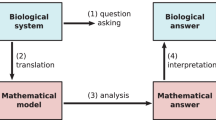Abstract
Here we argue that the concept of strategies, as it was introduced into biology by John Maynard Smith, is a prime illustration of the four dimensions of theoretical biology in the post-genomic era. These four dimensions are: data analysis and management, mathematical and computational model building and simulation, concept formation and analysis, and theory integration. We argue that all four dimensions of theoretical biology are crucial to future interactions between theoretical and empirical biologists as well as with philosophers of biology.
Similar content being viewed by others
References
Agrawal A.A., Laforsch C. et al. (1999). Transgenerational induction of defenses in animals and plants. Nature 401: 60–63
Amundson R.(2005). The Changing Rule of the Embryo in Evolutionary Biology: Structure and Synthesis. Cambridge University Press, New York
Axelrod R.M. (1990). The Evolution of Cooperation. Penguin Books, London New York
Axelrod, R.M. (1997). The Complexity of Cooperation: Agent-based Models of Competition and Collaboration. Princeton University Press, Princeton N.J.
Bicchieri C., Jeffrey R.C. et al. (1999). The Logic of Strategy. Oxford University Press, New York
Bonner J.T. (2000). First Signals: The Evolution of Multicellular Development. Princeton University Press, Princeton
Bowles S. (2004). Microeconomics: Behavior, Institutions, and Evolution. Princeton University Press, New York Princeton N.J. Russell Sage
Brooks J.L. (1965). Predation and relative helmet size in cyclomorphic daphnia. Proc. Natl. Acad. Sci. 53: 119–126
Charlesworth B. (2004a). Anecdotal, historical and critical commentaries on genetics. John Maynard Smith: January 6, 1920–April 19, 2004. 168: 1105–1109
Charlesworth B. (2004b). John Maynard Smith (1920–2004). Curr. Biol. 14(10): R365–R366
Gigerenzer G., Selten R. (2001). Bounded Rationality: The Adaptive Toolbox. MIT Press, Cambridge Mass
Gintis H. (2000). Game Theory Evolving a Problem-centered Introduction to Modeling Strategic Behavior. Princeton University Press, Princeton N.J.
Grafen A. (2000). Developments of the price equation and natural selection under uncertainty. Proc. R. Soc. Lon. B 267(1449): 1223–1227
Hagen E.H. and Hammerstein P. (2005). Evolutionary biology and the strategic view of onotogeny: genetic strategies provide robsutness and flexibility in the life course. Res. Hum. Dev. 2: 87–101
Hall B.K. (1998). Evolutionary Developmental Biology. Chapman & Hall, London, New York
Hammerstein P. 1996. Darwinian adaptation, population genetics and streetcar theory of evolution. J. Math. Biol. 34: 511–532
Hammerstein P. (2003). Genetic and Cultural Evolution of Cooperation. MIT Press in cooperation with Dahlem University Press, Cambridge Mass
Hammerstein P. and Hagen E.H. 2005. The second wave of evolutionary economics in biology. Trends. Ecol. Evol. 20(11): 604–609
Hofbauer J., Sigmund K.,(1988). The Theory of Evolution and Dynamical Systems: Mathematical Aspects of Selection. Cambridge University Press, Cambridge [England], New York
Hofbauer J. and Sigmund K.,(1998). Evolutionary Games and Population Dynamics. Cambridge University Press, Cambridge, New York, NY
Karlin S. (2005). John Maynard Smith and Recombination. Theor. Popul. Biol. 68(1): 3–5
Komarova N.L. (2004). Replicator-mutator equation, universality property and population dynamics of learning. J. Theor. Biol. 230(2): 227–239
Laubichler M.D. (2005). A constrained view of Evo Devo’s Roots. Science 309: 1019–1020
Maynard Smith J. 1958. The Theory of Evolution, [Harmondsworth, Middlesex], Penguin Books.
Maynard Smith J. (1968). Mathematical Ideas in Biology. Cambridge U.P., London
Maynard Smith J. (1974). Models in Ecology. University Press, Cambridge [Eng.]
Maynard Smith J. (1978). The Evolution of Sex. Cambridge [Eng.], Cambridge University Press, New York
Maynard Smith J. (1982). Evolution and the Theory of Games. Cambridge University Press, Cambridge New York
Maynard Smith J. (1988). Games, Sex, and Evolution. Harvester-Wheatsheaf, New York
Maynard Smith J. (1989). Evolutionary Genetics. Oxford University Press, Oxford, New York
Maynard Smith J. (1999). Shaping Life: Genes, Embryos, and Evolution. Yale University Press, New Haven
Maynard Smith J. and E. Szathmâary (1995). The Major Transitions in Evolution. W.H. Freeman Spektrum, Oxford New York
Michod R.E. 2005. John Maynard Smith. Annu. Rev. Genet. 39: 1–8
Noe R., J.A.R.M.v. Hooff et al. (2001). Economics in Nature: Social Dilemmas, Mate Choice, and Biological Markets. Cambridge University Press, Cambridge, UK, New York, NY
Page K.M. and Nowak M.A. (2002). Unifying evolutionary dynamics. J. Theor. Biol. 219(1): 93–98
Price G.R. (1970). Selection and covariance. Nature 227(5257):520–521
Raff R.A. (1996). The Shape of Life: Genes, Development, and the Evolution of Animal Form. University of Chicago Press, Chicago
Selten R. (1991). Game Equilibrium Models. Springer Verlag, Berlin New York
Sigmund K. (2005). John Maynard Smith and evolutionary game theory. Theor. Popul. Biol. 68(1): 7–10
Skyrms B. (1996). Evolution of the Social Contract. Cambridge University Press, Cambridge, New York
Skyrms B. (2004). The Stag Hunt and the Evolution of Social Structure. Cambridge University Press, Cambridge, UK, New York
Spratt B.G. (2004). John Maynard Smith (1920–2004). Infect. Genet. Evol. 4(4): 297–300
Szathmary E. and Hammerstein P. (2004). Obituary: John Maynard Smith (1920–2004). Nature 429(6989): 258–259
van Veelen M. 2005. On the use of the price equation. J. Theor. Biol. 237(4): 412–426
Von Neumann J., Morgenstern O. (1953). Theory of Games and Economic Behavior. Princeton University Press, Princeton
Wagner G.P. (2000). What is the promise of developmental evolution? Part I: why is developmental biology necessary to explain evolutionary innovations? J. Exp. Zool. 288(2): 95–98
Wagner G.P. (2001). What is the promise of developmental evolution? Part II: a causal explanation of evolutionary innovations may be impossible. J. Exp. Zool. 291(4): 305–309
Wagner G.P. and Larsson H.C.,(2003). What is the promise of developmental evolution? III. The crucible of developmental evolution. J. Exp. Zool. B: Mol. Dev. Evol. 300(1): 1–4
Author information
Authors and Affiliations
Corresponding author
Rights and permissions
About this article
Cite this article
Laubichler, M.D., Hagen, E.H. & Hammerstein, P. The strategy concept and John Maynard Smith’s influence on theoretical biology. Biol Philos 20, 1041–1050 (2005). https://doi.org/10.1007/s10539-005-9022-6
Received:
Accepted:
Published:
Issue Date:
DOI: https://doi.org/10.1007/s10539-005-9022-6




